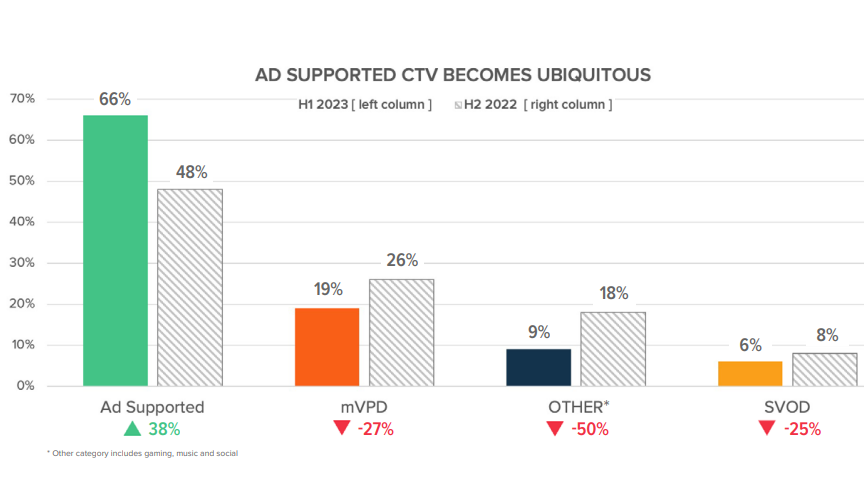
Ad-supported apps drew the vast majority of time spent watching connected TV in the first half of 2023, but the level of attention paid to streaming ads fell, according to a new report from TVision.
TVision said 66% of CTV viewing went to ad-supported apps in the first half of the year, up 38% from a 48% share in the second half of 2023.
The share of viewing for virtual multichannel video programming distributors fell 27% to a 19% share and viewing of subscription VOD app dropped 25% to 6%, TVision said.
But while more people are watching ad-supported streaming, the attention paid to streaming ads dropped.
TVision found that CTV ad attention dropped from 31.2% to 29.6%.
CTV presence-in-room, which signals whether a viewer is in the room and able to receive the message, dropped from 59.2% to 55.9%. Linear attention and viewer presence both slightly increased.
TVision said the dip in attention was party caused by more people watching. It also noted that most CTV apps run a clock during commercial breaks letting viewers know exactly when they should return to the room as programming resumes.
Overwhelmingly, CTV ads are delivered when the majority of viewers are not watching CTV ads are generally delivered evenly across a 24-hour day and do not align with how viewers tune in to CTV programming.
TVision found that 40% of CTV ads are delivered in lower-value late-night, overnight, and morning dayparts. That compares to linear TV ads, where only 20% of commercials are delivered in these less-attentive time periods.
The app generating the most attention is ad-free Apple TV Plus, with an attention index of 136.7, compared to a CTV average of 119.1. YouTube had an attention share of 120.9 and Amazon Prime Video had a 119.4 score. Netflix and Peacock were below average with indexes of 113.4 and 112 respectively.
During the first half of the year, Netflix increased its household reach to 62.9% the most of any streaming app.
“It’s likely that the new ad-supported subscription model helped propel Netflix to an increase in subscribers in the first half of the year,” TVision said. “But Netflix’s deep well of content including returning series like You and Bridgerton, as well as new shows like Night Agent also help Netflix maintain its prominence.”
Second in reach was YouTube, which posted a gain to 58.6%. Other apps increasing reach were Peacock, Paramount Plus and Tubi.
YouTube was tops in share of time spent viewing at 17.3%, followed by Netflix at 11.5%
Disney Plus led in co-viewing with 1.53 people in front of the screen per hour viewed, followed by Paramount Plus at 1.48 and Philo at 1.41.

Although overall streaming viewing time continues to grow as the number of CTV enabled households has ticked up to 84%. But the number of apps that are watched in Americais declining. Households have gone from watching an average of 7.3 apps at the start of the pandemic in Q2 2020 to 6.6 apps in Q2 2023. Meanwhile 23% of homes use 10 or more apps.
Travel advertisers increased their spending on CTV by 41% and restaurants boosted spending by 20%. Government and organizations cut back b 52% and retailers reduced expenditures by 15% compared to the the second half of 2022, which included the Chrstimas holiday.
“Legacy television companies jumped on board the subscription-first model,” TVision said in its report. “But with new economic realities and household reach for CTV settling to a constant at approximately 82-84% of all households over the last few years, the streaming industry must pivot to find new revenue. With most time spent viewing now taking place in apps with ad-supported models, it’s clear that subscription-only is out and ad-supported CTV is here to stay.
“With access to more granular insights about CTV audience engagement, viewer attention and in-room presence, the opportunity exists for advertisers to engage much more effectively with CTV audiences,” the report said.







